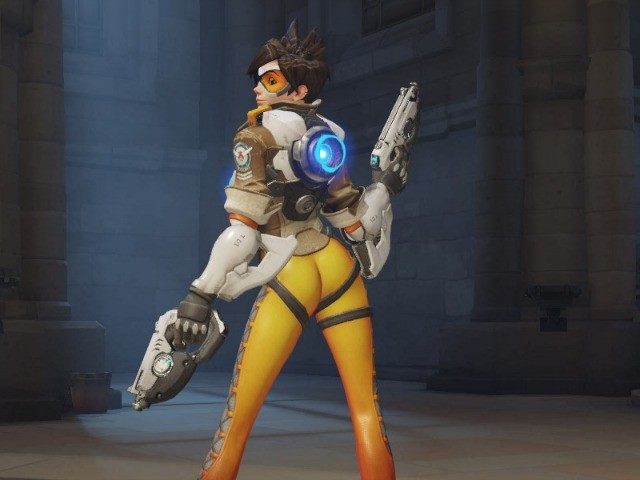Last month the game development and publishing company Activision Blizzard announced the removal of a sexualised character pose from its game Overwatch (a team-based shooter, currently in early beta) after a player of the game submitted a criticism of the pose on the company’s forums. The pose featured the character ‘Tracer’ in a skintight wetsuit with her backside facing the player, as she looked over her shoulder and smiled. Blizzard’s justification for the removal was that the pose did not accurately reflect the character of Tracer.
This justification is a euphemism – used to condone development choices, instead of responding to the actual pretext for disapproval, i.e. the inappropriate sexualisation of female characters. Of course, the end result was that Blizzard did remove the sexualised pose, and therefore its female characters are slightly less objectified, and that at least is something new, so does it matter that their official reasons for doing so are weak? They could have justified their action on grounds of acknowledging gender fluidity and diversity (in fact, that was the original justification, since superseded), and showing a greater maturity by admitting the character pose sought to appeal to solely a heteronormative male gamer. Yet Blizzard chose not to engage with the issue of gender and used harmless characterisation to justify its decision. Same end, different method, easier execution. The disadvantage is that by placing these choices under the umbrella of characterisation and story, actual considerations of race and gender are irrelevant.
The reason Blizzard used this excuse is that if it instead actually engaged with the issue at hand, it would have more to reckon with than just the complaint of a forum commentator, and would have to reconsider many decisions of bodily representation. One such would be ‘Widow’, another female character from Overwatch who is far more suspect than Tracer when it comes to matters of sexual objectification. By keeping to the justification of story Blizzard’s back is covered, because Widow’s objectification is arguably justified by story. She’s (supposedly) just proud of her sexuality, and that’s why her sexual pose is such a big feature of her appearance. On the grounds of ‘characterisation’ alone, there’s no apparent reason for her to become less objectified because her costume fits the dictates of who Blizzard thinks she is.

This way nothing has to be changed because the whole question is covered by story. Except Widow’s current story advertises her sexuality more to the viewer than anyone else. Do other characters acknowledge her costume in any way? Does her costume affect them? No, because it was never designed that way; it was designed for a player. The only people who see her costume are ourselves, and the underlying assumption is that Widow’s pride in her (hetero)sexuality can only be reflected in a way that conforms to the male gaze. Instead of, say, having a relationship, or by communicating this with other characters, she is the cliché that strikes a ‘sexy’ pose for the horny heterosexual male gamer.
More recently, and in an unrelated incident, Beamdog (the relatively young game development company responsible for the recently released reboots of an old-school RPG) decided to remove a piece of dialogue from Baldur’s Gate: Siege of Dragonspear after receiving complaints (the character ‘Minsc’ made a joke about Gamergate, with the line: “It’s about ethics in heroic adventuring”). For the non-geeks out there, Gamergate was ostensibly a pro-ethics in journalism movement originating in late 2014, which was in reality just a vicious tribe of male gamers trying to legitimise their campaign of harassment and slurs against Depression Quest designer Zoe Quinn and female gamers in general. After accomplishing its goal of strengthening magazine employee guidelines the movement continues to exist, and continues to discredit its supposed purpose.
On the removal of Minsc’s dialogue, Trent Oster, CEO of Beamdog gave the following statement
“Minsc has a line which generated controversy. Looking back on the line, we agree with the feedback from our community, it has nothing to do with his character and we will be removing the line”
The justification for this removal was identical to that of Blizzard’s: it doesn’t fit the character it was supposed to represent. The company effectively elides blame and responsibility for its content by situating all of its ideologies under the purview of story – no matter how backward or hate-fuelled they are. It refuses to acknowledge that by writing that line for a character of its own making, it is committing a fourth-wall breaking call-out to a cause as ambiguous as it is notorious.
Beamdog’s decision shows that this euphemism (known as the Thermian Argument) is easily exploited for any purpose, even to redact commentary. Is anyone fooled? Thus the questions: What can a character say regarding our reality while still counting as authentic? Does this sexual pose ‘fit’ a certain character? Are characterisation and story the primary qualifiers for in-game text? By ascribing criteria for what a character is, there is a subtle bypass of the fact that these characters are creations; a reflection of their creator’s selves and their sensibilities. These euphemisms are ultimately counterproductive to any honest aim to improve gender and race representation in mainstream games.
Words by Kacper Szozda


